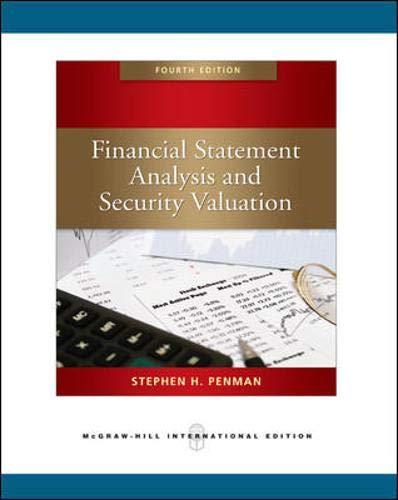Lucent Technologies, Inc., was formed from AT&T's Bell Laboratories research organiza- tion after the breakup of AT&T
Question:
Lucent Technologies, Inc., was formed from AT&T's Bell Laboratories research organiza- tion after the breakup of AT&T into the Baby Bells. Lucent designs, develops, and man- factures communication systems, supplying these systems to most of the world's telecom operators for both wired and wireless services for voice, data, and video delivery. In 1999 Lucent reported $38.301 billion in revenues, against $31.806 billion in 1998 and $27.611 billion in 1997. Analysts have complained about the quality of Lucent's reported earnings over the years. A. What questions arise regarding the quality of Lucent's earnings for 1997, 1998, and 1999 from the partial cash flow statements in Exhibit 17.5? Operating activities Net income Partial Consolidated Statements of Cash Flows (dollars in millions) Adjustments to reconcile net income to net cash (used in) provided by operating activities, net of effects from acquisitions of businesses Year Ended September 30 1999 1998 1997 $4,766 $1,035 $ 449 Cumulative effect of accounting change (1,308) 0 0 Business restructuring reversal Asset impairment and other charges Depreciation and amortization Provision for uncollectibles (141) (100) (201) 236 0 81 1,806 1,411 1,499 75 149 136 Tax benefit from stock options 367 271 88 Deferred income taxes 1,026 56 (21) Purchased in-process research and development 15 1,683 1,255 Adjustment to conform Ascend and Kenan's fiscal years 169 0 0 Increase in receivables-net (3,183) (2,161) (484) increase in inventories and contracts in process (1,612) (403) (316) Increase (decrease) in accounts payable 668 2311 (18) Changes in other operating assets and abilities (2,320) 155 (397) Other adjustments for noncash items-net (840) (467) 58 Net cash (used in) provided by operating activities $ (275) $1,800 $2,129 B. How do deferred tax footnotes help in ascertaining the quality of the accounting? Does the note below (from the 1999 report) raise any quality questions?
The components of deferred tax assets and liabilities at September 30, 1999, and 1998 are as follows: September 30 Deferred Income Tax Assets 1999 1998 1997 Employee persions and other benefits-net $ 442 $1,520 $1,777 Business restructuring 6 165 112 Valuation allowance Other Reserves and allowances Net operating loss/credit carryforwards Total deferred tax assets 1,009 1,137 887 226 239 107 (179) (261) (234) 344 526 664 $1,848 $3,326 $3,313 Deferred income tax abilities Property, plant, and equipment $ 628 $ 399 $ 478 Other 511 391 240 Total deferred tax liabilities $1,139 $ 790 $ 718 C. Lucent reported effective tax rates of 33.9 percent in 1999, 35.3 percent in 1998, and 36.8 percent 1997. Do these rates raise quality questions? D. Look at the footnote for the pension cost that follows. Does this note revise your assess- ment as to the quality of earnings reported from 1997 to 1999? Components of Net Periodic Benefit Cost Year Ended September 30 1999 1998 1997 Pensian cost Service cost $ 509 $ 331 5312 Interest cost on projected benefit obligation 1,671 1,631 1,504 Expected return on plan assets (2.957) (2.384) (2,150) Amortization of unrecognized prior service cost 461 164 149 Amortization of transition asset (300) (300) (300) Amortization of net loss 2 0 0 Charges for plan curtailments 0 0 56 Net pension credit (614) $1558) $ (329) Postretirement cost Service cost s 80 $ 63 Interest cost on accumulated benefit obligation 537 540 Expected return on plan assets (308) (263) Amortization of unrecognized prior service cost 53 53 Amortization of net loss (gain) 6 3 Charges for plan curtailments 0 0 Net postretirement benefit cost 358 $396 Pension and postretirement benefits Discount rate Expected return on plan assets Weighted-average assumptions as of September 30 7.25% 6.0% 9.0% 9.0% Rate of compensation increase 4.5% 4.5%
Effective October 1, 1998, Lucent changed its method for calculating the market-related value of plan assets used in determining the expected return-on-asset component of anal net pension and posetirement benefit cost. Under the previous accounting method, the calculation of the market-related value of plan assets included only interest and dividends immediately, while all other realized and cerealized gains and losses were amortized on & straight-line basis over a five-year period. The new method used to calculate market-related value includes immediately an amount based on Lucent's historical asset returns and mor tizes the difference between that amount and the actual return on a straight-line basis over a five-year period. The new method is preferable under Statement of Financial Accounting Standards No. 87 because it results in calculated plan osset values that are closer to current fair value, thereby lessening the accumulation of unrecognized gains and losses while still mitigating the effects of anmaal market value fluctuations. The cumulative effect of this accounting change velated to periods prior to fiscal year 1999 of $2,150 ($1.308 after-tax, or $0.43 and 50.42 per basic and diluted share, respec- tively) is a one-time, noncash credit to fiscal 1999 earnings. This accounting change also resulted in a reduction in benefit costs in the year ended September 30, 1999, that increased income by $427 (5260 after-tax, or $0.09 and 50.08 per basic and diluted share, respectively) as compared with the previous accounting method. A comparison of pro forma amounts below shows the effects if the accounting change were applied retroactively: Year Ended September 30 1998 1997 Pro forma net income $1,276.00 $657.00 Earnings per share-basic $ 0.43 5 0.23 Earnings per share-diluted $ 0.42 $ 0.22
Step by Step Answer:

Financial Statement Analysis And Security Valuation
ISBN: 9780071267809
4th International Edition
Authors: Penman-Stephen-H, Steven Penman





